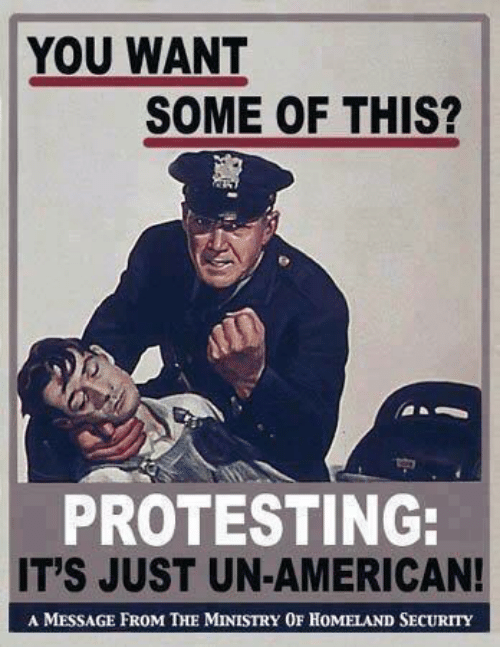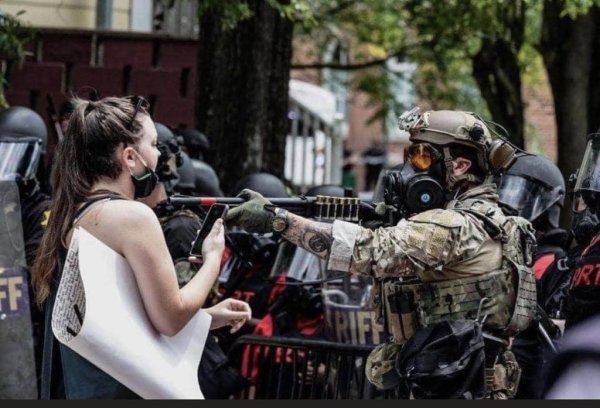
THE NEW YORKER: In early June, after the killing of George Floyd, when tens of thousands of mostly peaceful demonstrators assembled in cities across the country to protest police brutality, the Department of Homeland Security sent hundreds of its agents to patrol the crowds. They cleared space for a Presidential photo op in front of St. John’s Church, in Washington, D.C., by forcibly removing demonstrators, and in New York City they reportedly made at least one arrest at gunpoint. The legal rationale for their being on the scene was a statute from 2002 that gave them broad authority to protect federal property and personnel. This mandate sounded just vague enough to escape mainstream notice at the time, when police officers were being filmed tear-gassing and beating protesters. But a pressing question remains, which the D.H.S. leadership can’t easily answer: What are agents from Customs and Border Protection and Immigration and Customs Enforcement doing in the streets of U.S. cities nowhere near the border, policing citizens who have broken no laws?
Earlier this month, D.H.S. went further, sending SWAT teams from C.B.P. to Portland, Oregon, to quell ongoing protests in front of a federal building downtown. “We do not want you here,” the state’s Democratic governor, Kate Brown, said that she told D.H.S. officials when she learned of their plans. “It provokes confrontation to have federal troops on the streets.” Chad Wolf, the acting head of the department, ignored her, and held what a former official described to me as a “pep rally” with agents before deploying more of them to the city. In a statement, Wolf said, “The city of Portland has been under siege for forty-seven straight days by a violent mob, while local political leaders refuse to restore order.” He added, a few days later, as opposition to the D.H.S. presence grew, “we will not retreat.”
By mid-July, federal authorities had made about forty arrests in Portland, and there were news reports and video footage of agents beating protesters, including a fifty-three-year-old Navy veteran, who was left with a shattered hand. In a widely circulated video, two agents dressed in military camouflage were shown pulling a protester into an unmarked gray minivan. “The nightly disturbances in Portland were not national news until now,” a former D.H.S. official told me. “Department leadership is putting officers in a very difficult position by not explaining what they’re doing and why. If this mission was supposed to be about assisting Federal Protective Services”—the agency in charge of guarding federal property—“then what are they doing pulling people into minivans rented from the Portland airport? How does protecting federal property become pepper spraying and batoning people?” MORE
RELATED: “Homeland” is an anxious, combative word: it denotes a place under assault, in need of aggressive defense from shape-shifting dangers. The original proposal for the D.H.S. described the agency as “a new government structure to protect against invisible enemies that can strike with a wide variety of weapons”; one hypothetical example of an invisible enemy was “a non-citizen that intends to enter our nation and attack one of our chemical facilities.” The nation used to protect itself against other nations and their hostile military forces, but now it had to fear individuals. This is the premise on which secret police forces are built. Their stated purpose is to find danger where normal human activity appears to be taking place. The D.H.S. began with mobilizing against the foreign-born, via Immigration and Customs Enforcement (which replaced the Immigration and Naturalization Service). The logic of the secret police, however, dictates that it perpetually has to look in new places for threats.
When Bush signed the Homeland Security Act, in November of 2002, bringing the D.H.S. into existence, he touted it as “the most extensive reorganization of the federal government since Harry Truman signed the National Security Act,” and spoke of “ruthless killers who move and plot in shadows.” He promised, “We’re on the hunt. One person at a time.” Bush’s words echoed the promise that fuelled Vladimir Putin’s rise in Russia. In a speech that brought him to sudden prominence, in 1999, the former K.G.B. colonel promised to “hunt down” terrorists and “snuff them out in the outhouse,” if that’s where they happened to be found. The secret police, even when it looks and appears to act like an army, always has a single individual as its target. Its goal is to make a person, alone, face the might of the state.
In Portland, the men in military-style uniforms have been picking up and detaining individuals while they are walking alone, often after a protest ends. At the press conference on Tuesday, Wolf owned the tactic of tracking people down and picking them up at some distance from protests. “When you have five hundred, six hundred violent individuals, violent criminals across the street from you, trying to inflict harm on your property and at law-enforcement officers . . . we don’t go into that crowd,” he said. “We don’t try to go into a violent crowd of four hundred people and try to arrest people—that’s dangerous.” Mark Morgan, the acting commissioner of U.S. Customs and Border Protection, explained that his troops were using unmarked vehicles because police vehicles in other cities had been attacked by protesters; similarly, he said, his men didn’t have their names on their uniforms for fear of attacks on their homes and families. The C.B.P. is the largest law-enforcement agency in the country. Its leader—who at the same briefing stated that his troops are highly trained and experienced in putting down riots—and his boss, Chad Wolf, were telling the nation that they are terrified of the protesters. These men represent a government agency born of fear. Their tactics are designed to engender an equal amount of fear in the people they see as their enemies. The secret police is always a terror-production machine. MORE
PREVIOUSLY: Q&A With Philadelphia DA Larry Krasner

